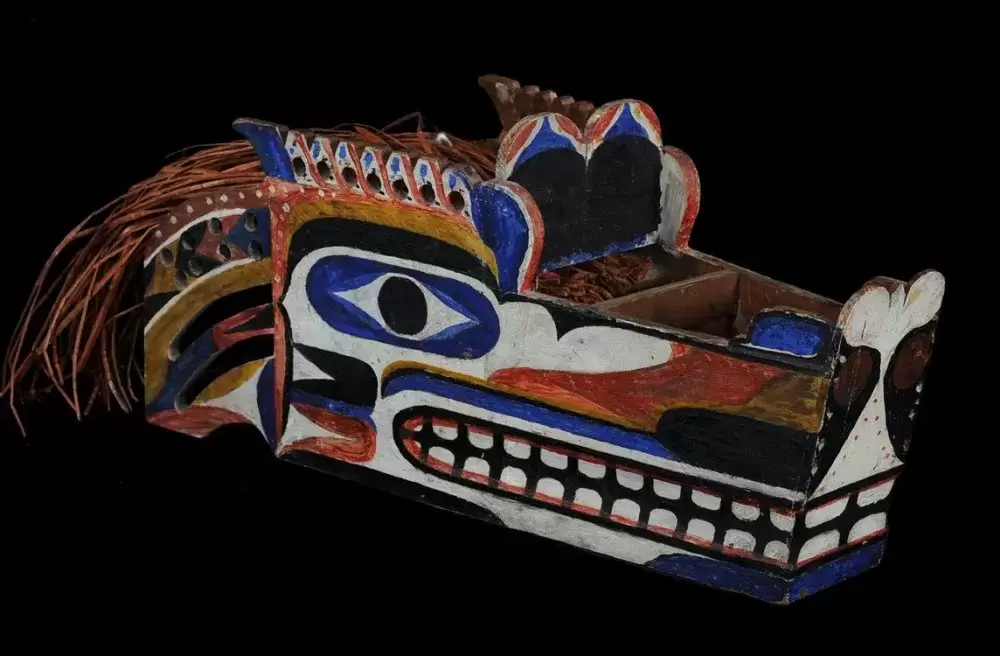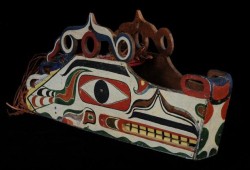A pair of Hinkeetsum masks linked to the revival of Nuu-chah-nulth cultural tradition has been sold at public auction on the Lower Mainland.
The two sea serpent masks, one male, the other female, appeared on the icollector.com Web site last week. Darrell Ross and Len Lindstrom Watts monitor the movement of Nuu-chah-nulth cultural items, and these particular pieces immediately raised alarm bells.
“There is a collectors’ network on the West Coast, and we receive almost daily updates on auctions and private sales,” Ross said.
Their first thought was that the masks were the ones used in the first Nuu-chah-nulth cultural event sanctioned by Governor General Vincent Massey, Lindstrom explained.
In October 1949, the late Tseshaht artist, Dr. George Clutesi, called on the Governor General to overturn the infamous potlatch ban and allow Canada’s First Nations to practice their traditional culture.
“The Governor General told him, ‘Go back home and dance.’ The significance to the Nuu-chah-nulth is that these are the two Hinkeetsum masks that they went home to dance with,” Lindstrom said.
Ross said there are a number of videos and photographs depicting the two pieces in close detail, and it allowed the two cultural sleuths to positively link the masks to the images listed on the auction site.
“We have a video called Alberni Dancers in our archives. It was focused on the potlatch ban, on George Clutesi’s presentation and on the performance that was given for Princess Elizabeth,” Ross said.
“We superimposed the photos and the paint lines and the markings matched up,” Lindstrom said. “Using Photoshop, I checked the opacity on them to see how close they were. You can totally tell they’re them.”
Lindstrom said the first cultural event was recorded on film, and the video is now available through the Royal B.C. Museum. The masks are brought to a table by “Big Annie,” who is believed to have been a member of the Mack family.
“She brings them out of her house. She’s got three girls in front of her. She puts [the female mask] on her head and dances around a bit. Then she puts it on one of the children’s head, and gets them to dance with it,” he said. “Later, there are six or seven people dancing in from of the old Somass Hall, each with a Hinkeetsum mask. But these are the two that Big Annie brought out.”
The auction-house listing certainly acknowledges the importance of the masks. “19TH C. Nuu-chah-nulth Headdress Used Many Times in Sea Serpent Dance, Representing a Female - Ucluelet, B.C. Pasted [sic] From One Generation to the Next - Family Provenance Available 21" L. 10" W. Good Condition”
Lindstrom, who was already searching for prints by his late brother-in-law, went to the auction house to view the items, and had one reaction.
“Beautiful,” he said. “The guy said he had to do some restoration on them. He had had them for a few weeks.”
One good thing is that the auctioneer appeared very knowledgeable about Nuu-chah-nulth artwork, and respectful of the culture.
“He said he had already had some interest. He said the person he had talked to – he wouldn’t tell me who – is somebody that will take care of them and will keep them accessible if the people wanted,” Lindstrom said. “I told him I would leave him my name and my number for the guy that purchases them, so at least we know where they are.”
Ross said losing important pieces of Nuu-chah-nulth heritage is upsetting.
“It sent me and Lennie for a loop,” he said. “He just went through a big memorial feast for his mother, and we used similar masks. The sea serpent mask is the centerpiece of most of the feasts.”
In Nuu-chah-nulth imagery, the Thunderbird reigns supreme, Ross explained. His ally, the sea serpent, flows from the whaling culture.
“Nuu-chah-nulth curtains all have the Thunderbird, and the sea serpents, either separately, or beside the Thunderbird. There’s usually two of them,” Ross said.
Late in the day, Lindstrom reported that a single lot of Nuu-chah-nulth items, including the Hinkeetsum masks, several shawls and prints, sold for approximately $26,000. He said he would attempt to locate the new owner through the auction house, following completion of the day’s business.
Ross said while it is good to be able to monitor the movement of cultural pieces, it would be better to be able to intervene. But that means money.
“We need some type of cultural fund where we can access some of this stuff, either for presentation or our own display,” Ross said. Until then, the drain of important Nuu-chah-nulth cultural items will continue, and even pieces with critical significance, such as the two Hinkeetsum masks, will go the highest bidder.








